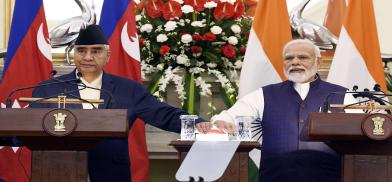With connectivity and energy cooperation, Modi’s upcoming Nepal visit puts ties back on track
India’s timely push for connectivity projects in Nepal under its Neighborhood First policy is crucial, especially when China has expanded its presence rapidly in the last decade in key infrastructure sectors in Nepal

Indian Prime Minister Narendra Modi is scheduled to visit Nepal on 16 May—a little over a month after Nepali Prime Minister Sher Bahadur Deuba visited India—to participate in an event to mark the birth anniversary celebration of Lord Buddha. Although the visit is a one-day visit, several crucial projects in hydropower and connectivity will be discussed between the two countries.
For Modi, this will be his fifth Nepal visit as prime minister, but the first since he returned to office in 2019. The visit shows the two nations have seemingly moved past the seemingly hibernation period that set in the ties after the boundary row erupted in 2020.
“The fact that the return visit is taking place in such close succession is a reflection of the closeness of high-level exchanges and as well as of the upward trajectory of our mutually beneficial partnership,” Indian Foreign Secretary Vinay Mohan Kwatra, a former envoy to Nepal, said on Friday in a special briefing.
Modi will begin his visit to Lumbini with a visit to the Mayadevi temple, followed by a foundation stone-laying ceremony for a Buddhist cultural center in the complex, he said.
Since last year, New Delhi has been pushing for fast-tracking the implementation of several of its key infrastructure projects in Nepal. Hydropower and connectivity are among the two most prominent sectors both countries are looking for to enhance cooperation.
Kwatra said that two leaders will pick up from where they left off in Delhi just last month and will build on their productive conversations in Delhi to expand our shared understanding and cooperation in multiple areas, including hydropower, development, partnership, and connectivity,”
India’s timely push for connectivity projects in Nepal under its Neighborhood First policy is crucial, especially when China has expanded its presence rapidly in the last decade in key infrastructure sectors in Nepal.
In fact, Modi, who is to fly from India’s Kushinagar to Lumbini in Nepal, will be avoiding a newly constructed international airport in the same Nepali city. The Gautam Buddha International Airport, which will be inaugurated by Deuba on Monday, a day before the Modi’s visit, is constructed by a Chinese company.
Earlier this week, Deuba said he will discuss West Seti and Pancheshwar projects directly with Modi. The two projects with hydropower components, which are lingering for a long, are of great importance to Nepal.
In the post-pandemic recovery period, when the rising import bills are depleting foreign exchange reserves of countries across the world, Nepal is keen on seeking large Indian investments and grants in areas that could help it bolster its forex.
And, hydropower is one of those promising sectors, which not only brings the much-needed investment but also gives a handsome return when the country would export electricity produced from these projects to India and Bangladesh.
Shankar P Sharma, Nepal’s ambassador to India, wrote in Indian Express, “Nepal is trying to reduce the external sector vulnerability in the medium and long term by exporting a higher volume of electricity to India and Bangladesh, attracting developers and investors…”
“For Nepal, it is a blessing to have the world’s fastest-growing economy with a massive middle-class population as an immediate neighbor with an open border,” he said, adding that more meaningful partnership in the coming days would further “deepen our economic partnership and long-standing friendship”
(SAM)








Post a Comment